2018 DODGE CHARGER air condition
[x] Cancel search: air conditionPage 403 of 553
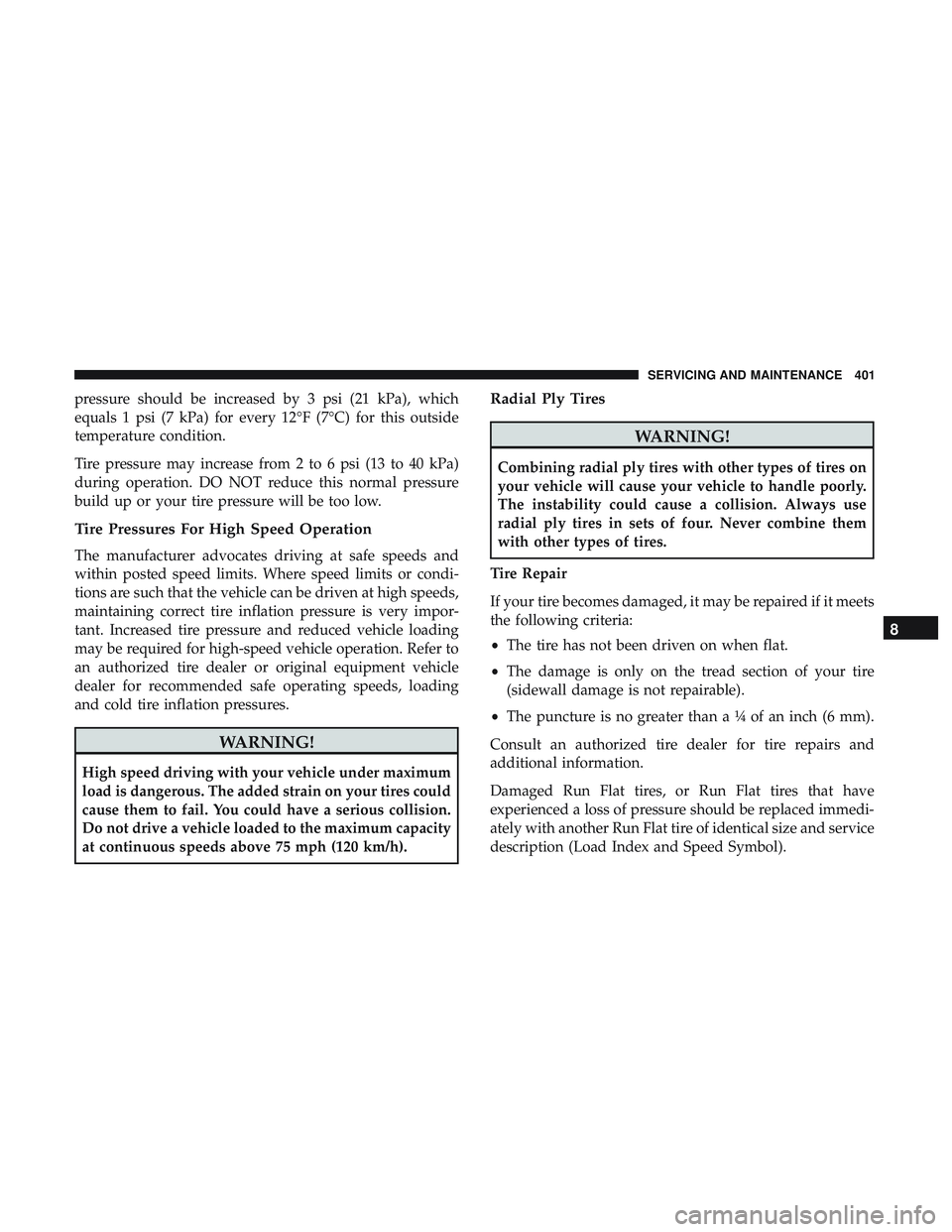
pressure should be increased by 3 psi (21 kPa), which
equals 1 psi (7 kPa) for every 12°F (7°C) for this outside
temperature condition.
Tire pressure may increase from 2 to 6 psi (13 to 40 kPa)
during operation. DO NOT reduce this normal pressure
build up or your tire pressure will be too low.
Tire Pressures For High Speed Operation
The manufacturer advocates driving at safe speeds and
within posted speed limits. Where speed limits or condi-
tions are such that the vehicle can be driven at high speeds,
maintaining correct tire inflation pressure is very impor-
tant. Increased tire pressure and reduced vehicle loading
may be required for high-speed vehicle operation. Refer to
an authorized tire dealer or original equipment vehicle
dealer for recommended safe operating speeds, loading
and cold tire inflation pressures.
WARNING!
High speed driving with your vehicle under maximum
load is dangerous. The added strain on your tires could
cause them to fail. You could have a serious collision.
Do not drive a vehicle loaded to the maximum capacity
at continuous speeds above 75 mph (120 km/h).
Radial Ply Tires
WARNING!
Combining radial ply tires with other types of tires on
your vehicle will cause your vehicle to handle poorly.
The instability could cause a collision. Always use
radial ply tires in sets of four. Never combine them
with other types of tires.
Tire Repair
If your tire becomes damaged, it may be repaired if it meets
the following criteria:
• The tire has not been driven on when flat.
• The damage is only on the tread section of your tire
(sidewall damage is not repairable).
• The puncture is no greater thana¼ofaninch (6 mm).
Consult an authorized tire dealer for tire repairs and
additional information.
Damaged Run Flat tires, or Run Flat tires that have
experienced a loss of pressure should be replaced immedi-
ately with another Run Flat tire of identical size and service
description (Load Index and Speed Symbol).
8
SERVICING AND MAINTENANCE 401
Page 404 of 553
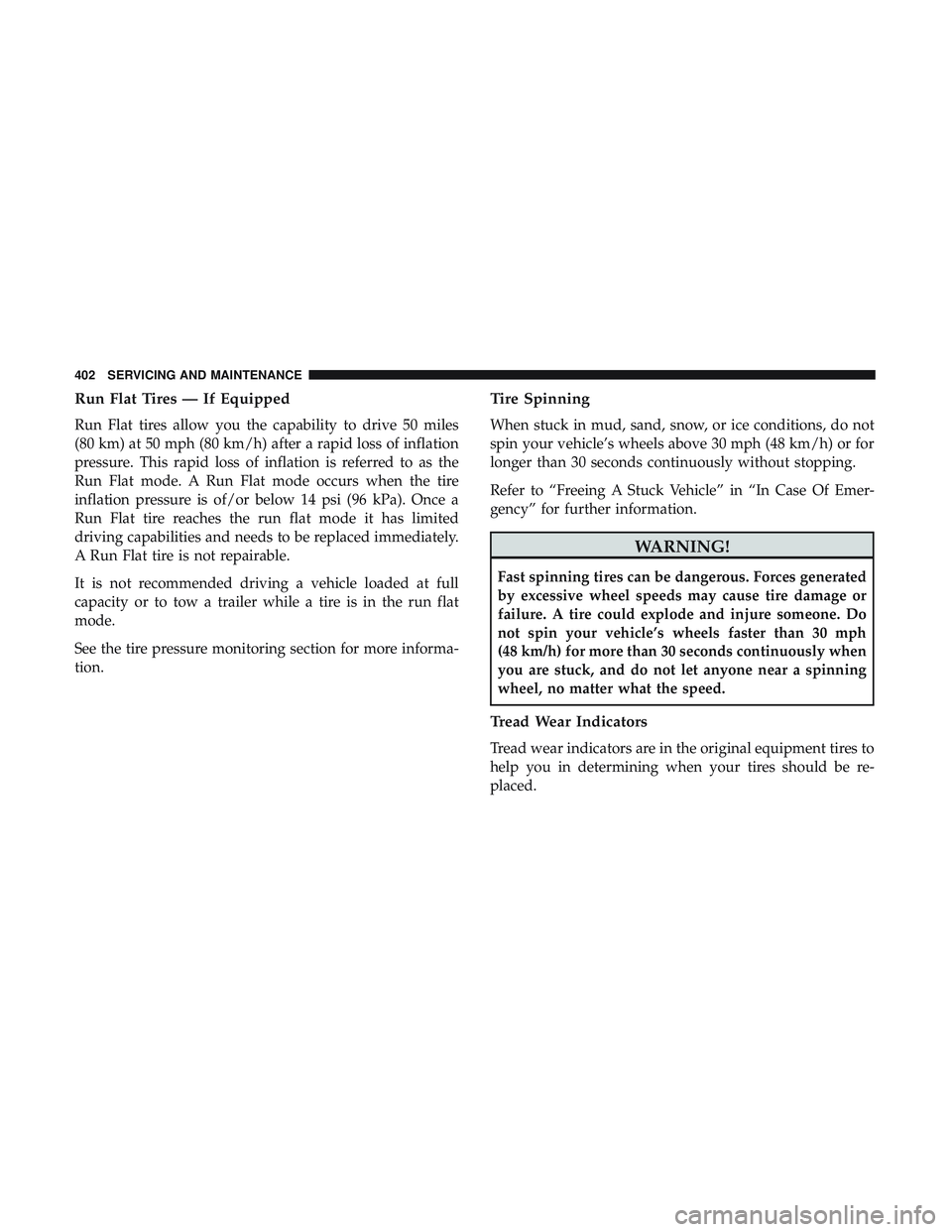
Run Flat Tires — If Equipped
Run Flat tires allow you the capability to drive 50 miles
(80 km) at 50 mph (80 km/h) after a rapid loss of inflation
pressure. This rapid loss of inflation is referred to as the
Run Flat mode. A Run Flat mode occurs when the tire
inflation pressure is of/or below 14 psi (96 kPa). Once a
Run Flat tire reaches the run flat mode it has limited
driving capabilities and needs to be replaced immediately.
A Run Flat tire is not repairable.
It is not recommended driving a vehicle loaded at full
capacity or to tow a trailer while a tire is in the run flat
mode.
See the tire pressure monitoring section for more informa-
tion.
Tire Spinning
When stuck in mud, sand, snow, or ice conditions, do not
spin your vehicle’s wheels above 30 mph (48 km/h) or for
longer than 30 seconds continuously without stopping.
Refer to “Freeing A Stuck Vehicle” in “In Case Of Emer-
gency” for further information.
WARNING!
Fast spinning tires can be dangerous. Forces generated
by excessive wheel speeds may cause tire damage or
failure. A tire could explode and injure someone. Do
not spin your vehicle’s wheels faster than 30 mph
(48 km/h) for more than 30 seconds continuously when
you are stuck, and do not let anyone near a spinning
wheel, no matter what the speed.
Tread Wear Indicators
Tread wear indicators are in the original equipment tires to
help you in determining when your tires should be re-
placed.
402 SERVICING AND MAINTENANCE
Page 415 of 553

WARNING!
The temperature grade for this tire is established for
a tire that is properly inflated and not overloaded.
Excessive speed, under-inflation, or excessive load-
ing, either separately or in combination, can cause
heat buildup and possible tire failure.
VEHICLE STORAGE
If you are leaving your vehicle dormant for more than 21
days, you may want to take these steps to protect your
battery.
• Disconnect the negative cable from the battery.
• Anytime you store your vehicle, or keep it out of service
(e.g., vacation) for two weeks or more, run the air
conditioning system at idle for about five minutes in the
fresh air and high blower setting. This will ensure
adequate system lubrication to minimize the possibility
of compressor damage when the system is started again.
BODYWORK
Protection From Atmospheric Agents
Vehicle body care requirements vary according to geo-
graphic locations and usage. Chemicals that make roads
passable in snow and ice and those that are sprayed on
trees and road surfaces during other seasons are highly
corrosive to the metal in your vehicle. Outside parking,
which exposes your vehicle to airborne contaminants, road
surfaces on which the vehicle is operated, extreme hot or
cold weather and other extreme conditions will have an
adverse effect on paint, metal trim, and underbody protec-
tion.
The following maintenance recommendations will enable
you to obtain maximum benefit from the corrosion resis-
tance built into your vehicle.
8
SERVICING AND MAINTENANCE 413
Page 509 of 553
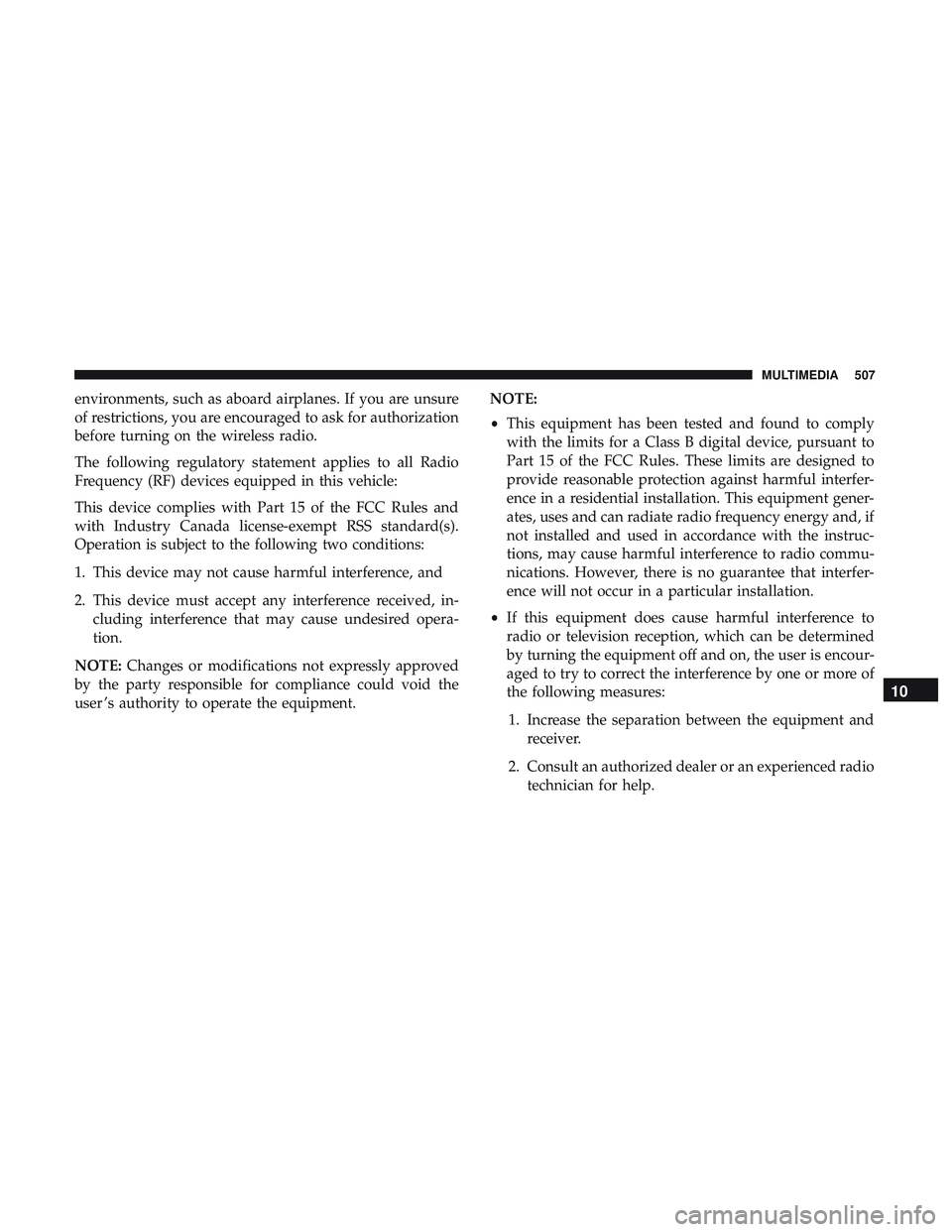
environments, such as aboard airplanes. If you are unsure
of restrictions, you are encouraged to ask for authorization
before turning on the wireless radio.
The following regulatory statement applies to all Radio
Frequency (RF) devices equipped in this vehicle:
This device complies with Part 15 of the FCC Rules and
with Industry Canada license-exempt RSS standard(s).
Operation is subject to the following two conditions:
1. This device may not cause harmful interference, and
2. This device must accept any interference received, in-cluding interference that may cause undesired opera-
tion.
NOTE: Changes or modifications not expressly approved
by the party responsible for compliance could void the
user ’s authority to operate the equipment. NOTE:
•
This equipment has been tested and found to comply
with the limits for a Class B digital device, pursuant to
Part 15 of the FCC Rules. These limits are designed to
provide reasonable protection against harmful interfer-
ence in a residential installation. This equipment gener-
ates, uses and can radiate radio frequency energy and, if
not installed and used in accordance with the instruc-
tions, may cause harmful interference to radio commu-
nications. However, there is no guarantee that interfer-
ence will not occur in a particular installation.
• If this equipment does cause harmful interference to
radio or television reception, which can be determined
by turning the equipment off and on, the user is encour-
aged to try to correct the interference by one or more of
the following measures:
1. Increase the separation between the equipment and receiver.
2. Consult an authorized dealer or an experienced radio technician for help.
10
MULTIMEDIA 507
Page 528 of 553
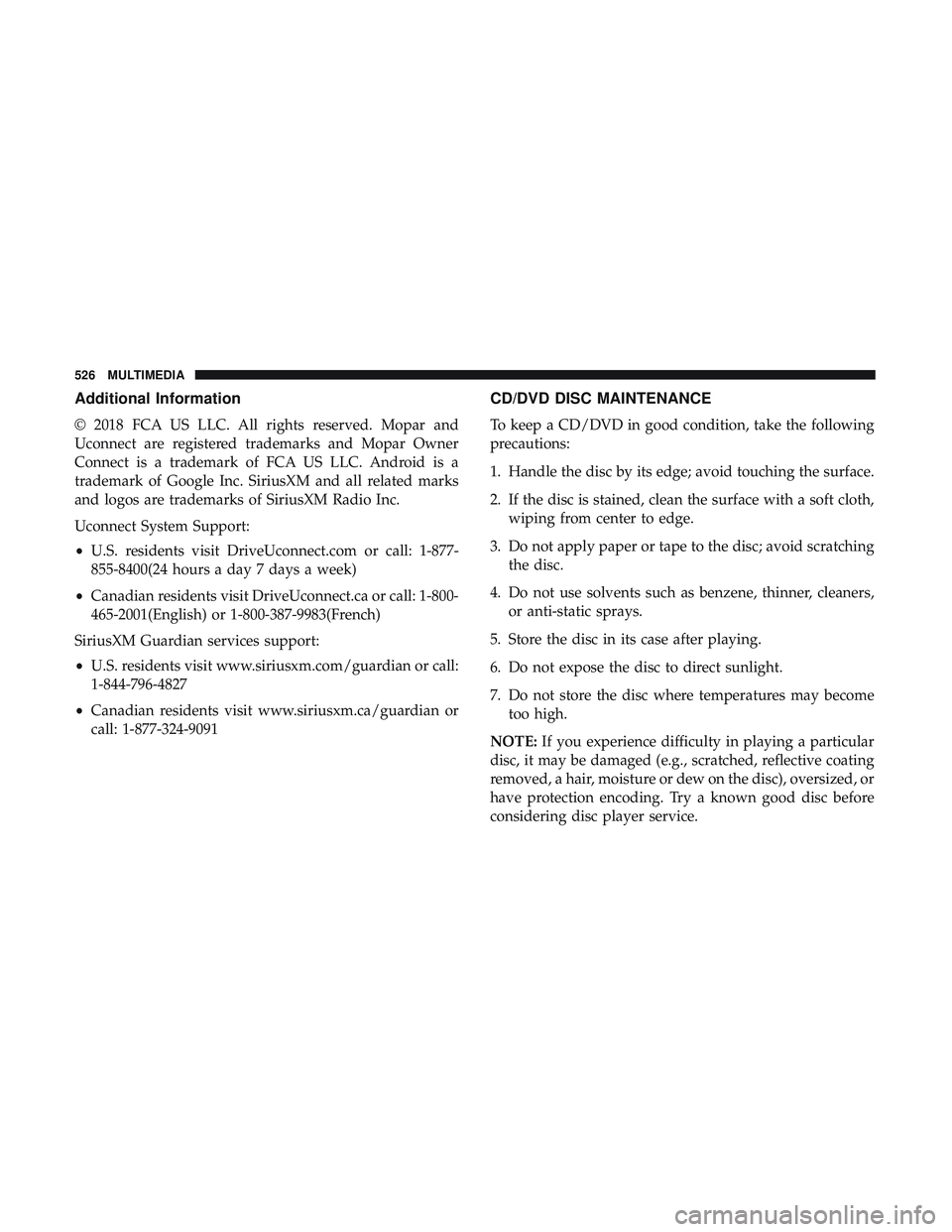
Additional Information
© 2018 FCA US LLC. All rights reserved. Mopar and
Uconnect are registered trademarks and Mopar Owner
Connect is a trademark of FCA US LLC. Android is a
trademark of Google Inc. SiriusXM and all related marks
and logos are trademarks of SiriusXM Radio Inc.
Uconnect System Support:
•U.S. residents visit DriveUconnect.com or call: 1-877-
855-8400(24 hours a day 7 days a week)
• Canadian residents visit DriveUconnect.ca or call: 1-800-
465-2001(English) or 1-800-387-9983(French)
SiriusXM Guardian services support:
• U.S. residents visit www.siriusxm.com/guardian or call:
1-844-796-4827
• Canadian residents visit www.siriusxm.ca/guardian or
call: 1-877-324-9091
CD/DVD DISC MAINTENANCE
To keep a CD/DVD in good condition, take the following
precautions:
1. Handle the disc by its edge; avoid touching the surface.
2. If the disc is stained, clean the surface with a soft cloth,
wiping from center to edge.
3. Do not apply paper or tape to the disc; avoid scratching the disc.
4. Do not use solvents such as benzene, thinner, cleaners, or anti-static sprays.
5. Store the disc in its case after playing.
6. Do not expose the disc to direct sunlight.
7. Do not store the disc where temperatures may become too high.
NOTE: If you experience difficulty in playing a particular
disc, it may be damaged (e.g., scratched, reflective coating
removed, a hair, moisture or dew on the disc), oversized, or
have protection encoding. Try a known good disc before
considering disc player service.
526 MULTIMEDIA
Page 536 of 553
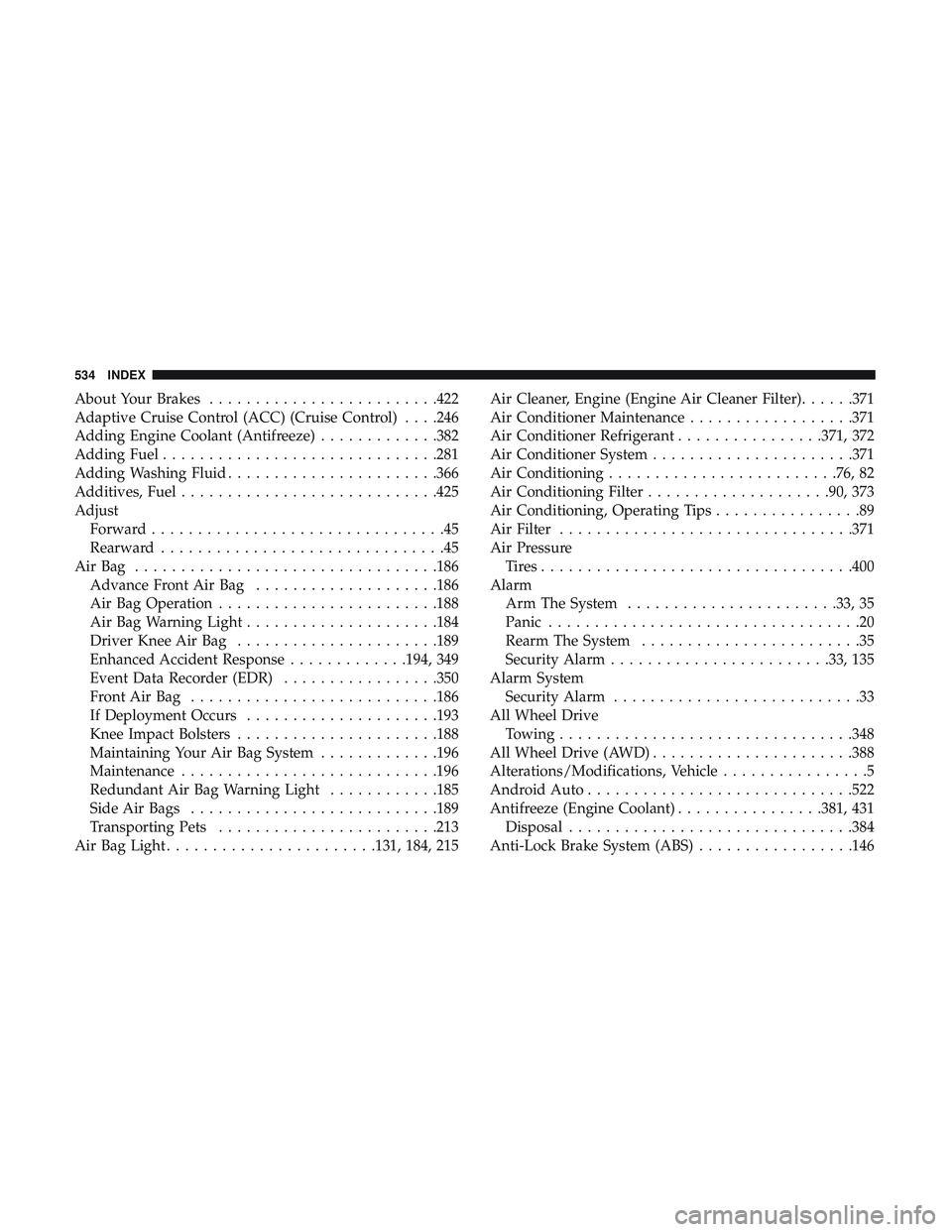
About Your Brakes........................ .422
Adaptive Cruise Control (ACC) (Cruise Control) . . . .246
Adding Engine Coolant (Antifreeze) .............382
Adding Fuel ............................. .281
Adding Washing Fluid .......................366
Additives, Fuel ............................425
Adjust Forward ................................45
Rearward ...............................45
AirBag ................................ .186
Advance Front Air Bag ....................186
Air Bag Operation ........................188
Air Bag Warning Light .....................184
Driver Knee Air Bag ..................... .189
Enhanced Accident Response .............194, 349
Event Data Recorder (EDR) .................350
FrontAirBag .......................... .186
If Deployment Occurs .....................193
Knee Impact Bolsters ..................... .188
Maintaining Your Air Bag System .............196
Maintenance ............................196
Redundant Air Bag Warning Light ............185
Side Air Bags .......................... .189
Transporting Pets ........................213
Air Bag Light .......................131, 184, 215 Air Cleaner, Engine (Engine Air Cleaner Filter)
......371
Air Conditioner Maintenance ..................371
Air Conditioner Refrigerant ................371, 372
Air Conditioner System ..................... .371
Air Conditioning ........................ .76, 82
Air Conditioning Filter ....................90, 373
Air Conditioning, Operating Tips ................89
Air Filter ............................... .371
Air Pressure Tires................................. .400
Alarm Arm The System .......................33, 35
Panic ..................................20
Rearm The System ........................35
Security Alar
m....................... .33, 135
Alarm System Security Alarm ...........................33
All Wheel Drive Towing ............................... .348
All Wheel Drive (AWD) ..................... .388
Alterations/Modifications, Vehicle ................5
Android Auto ............................ .522
Antifreeze (Engine Coolant) ................381, 431
Disposal ...............................384
Anti-Lock Brake System (ABS) .................146
534 INDEX
Page 540 of 553
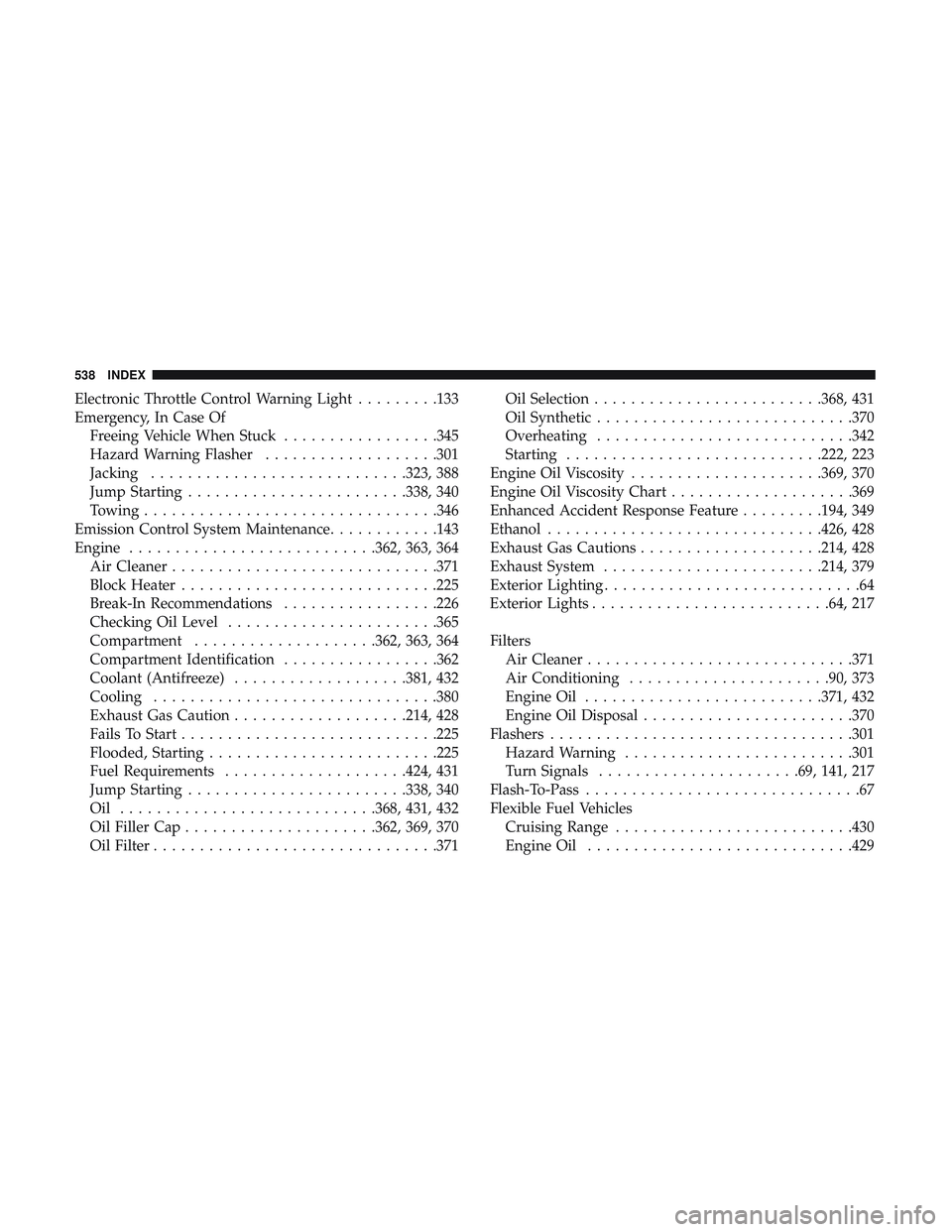
Electronic Throttle Control Warning Light.........133
Emergency, In Case Of Freeing Vehicle When Stuck .................345
Hazard Warning Flasher ...................301
Jacking ............................323, 388
Jump Starting ........................338, 340
Towing ............................... .346
Emission Control System Maintenance ............143
Engine .......................... .362, 363, 364
Air Cleaner ............................ .371
Block Heater ............................225
Break-In Recommendations .................226
Checking Oil Level .......................365
Compartment ....................362, 363, 364
Compartment Identification .................362
Coolant (Antifreeze) ...................381, 432
Cooling ...............................380
Exhaust Gas Caution ...................214, 428
Fails To Start ............................225
Flooded, Starting ........................ .225
Fuel Requirements ....................424, 431
Jump Starting ........................338, 340
Oil ............................368, 431, 432
Oil Filler Cap .....................362, 369, 370
Oil Filter ...............................371 Oil Selection
........................ .368, 431
Oil Synthetic ............................370
Overheating ............................342
Starting ............................222, 223
Engine Oil Viscosity .....................369, 370
Engine Oil Viscosity Chart ....................369
Enhanced Accident Response Feature .........194, 349
Ethanol ............................. .426, 428
Exhaust Gas Cautions ....................214, 428
Exhaust System ........................214, 379
Exterior Lighting............................
64
Exterior Lights ..........................64, 217
Filters Air Cleaner ............................ .371
Air Conditioning ..................... .90, 373
Engine Oil ..........................371, 432
Engine Oil Disposal .......................370
Flashers .................................301
Hazard Warning ........................ .301
Turn Signals ..................... .69, 141, 217
Flash-To-Pass ..............................67
Flexible Fuel Vehicles Cruising Range ..........................430
Engine Oil ............................ .429
538 INDEX